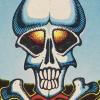Pop Power: A Q&A With Matthew Sweet
Wednesday, Sept. 18 @ 40 Watt Club

Photo Credit: Evan Carter
Casual fans remember Matthew Sweet best for “Girlfriend,” the catchy power-pop alterna-hit from his 1991 breakthrough album of the same name. But Sweet started playing with Lincoln, NE new-wave band The Specs in the late 1970s—you can hear the roots of his signature guitar-pop sound in their 1980 single, “Look Out Girl (You Need a Direction),” a song he wrote when he was 16. He subsequently moved to Athens and played in Community Trolls with Michael Stipe and then Oh-OK with Stipe’s sister, Lynda. Sweet’s solo career started in 1986 with his debut album, Inside. He returns to Athens on Wednesday to headline the 40 Watt Club.
FP: What was it like when you lived in Athens?
MS: When I lived in Athens, it was at the tail end of the classic era. The B-52s were still around town, along with bands like Pylon and Love Tractor and, of course, R.E.M., who were just blowing up. I was really a wide-eyed kid from Nebraska, just out of high school when I moved there, so it was all amazing to me. People in local bands were all friendly with each other, and the independent music scene was pretty intertwined. Later, it became more competitive, after R.E.M. got big.
I was lucky enough to have met them in Nebraska when I was still in high school and they were traveling through. I gave my demos to Michael Stipe and got a postcard from him saying he liked my songs, which meant the world to me. I loved all these bands before I moved to Athens—I had all their records. It’s crazy to think, but I was only in Athens for two years before I moved to New York to make my first record for Columbia. I cannot overstate how important R.E.M. were to so many young musicians—just a huge influence. By the time I left, there had been a big influx of musicians from other places.
FP: Your 2017 album Tomorrow Forever was funded by a Kickstarter campaign. Do you feel that crowdfunding is the future of making records or a new means to an end?
MS: I would say both. Crowdfunding is a great opportunity, although you don’t really make a profit from it, as you have to do all the manufacturing and recording out of it. But without it, it would be hard for a lot of artists to keep recording. For my next crowdfunding effort, I am finishing the record first, so supporters get it in a timely fashion.
FP: What’s it like playing with Ric Menck? He seems like the perpetually well-tuned engine that every car wants to run on. But he also seems like an amazing wealth of musical knowledge and experience. I can imagine the speakers in your tour bus never tire of awesome tunes.
MS: Ric is awesome, and we are very close friends, going back to my Athens days. And he has definitely been a huge influence on me with his vast knowledge of cool records. He’s kinda been my musical mentor through the years. He is one cool cat, but most of all, we love playing and recording together. He’s really like a brother to me. He’s a great, great drummer.
FP: You always have the best guitar tones, live and in the studio. What’s your preferred rig?
MS: I like so many different guitars and amps, and they each have their special qualities. Recently, I’ve been using a Marshall JCM800 live a lot—it’s a tube amp that has a master volume, which can be helpful, volume-wise. I record a lot with a Fender Tweed Deluxe amp—it just sounds so good. Sometimes I tour with one. I built my own clone of the Deluxe, too. For guitars, I really love stuff made by Dennis Fano. His guitars take from a lot of different classic brands and are a wonderful blend. They are my favorite guitars I’ve ever had, and I’ve owned a lot of guitars.
FP: How long have you been a collector of Margaret Keane’s work? Was the artwork on your last two albums inspired by her style, or are those actual Keane pieces? What was it like working on her biopic Big Eyes?
MS: My wife and I started collecting Keane and others from her genre and time—the early ’60s—in the ’90s. We had some prints and wondered, "Where are the originals?” We felt the Keane story was really interesting and thought it would make a great movie. Eventually, our friends Larry Karaszewski and Scott Alexander wrote a script. It was amazing seeing it come to fruition with Tim Burton directing. Amy Adams was just ideal as Margaret. Once it was made, we thought, "Our work is done!" We got to visit the set in Vancouver while they were filming—we were very excited.
The Tomorrow Forever artwork comes from an artist who used the name Maio. She was an amazing lady from Los Angeles who painted at the same time as Keane. The harlequin paintings are life-sized, huge canvases. She was a real favorite of ours, and it was great to use our originals by her in the album artwork.
More by Eric Shea
-

Sunwatchers and Elf Power Show How Music Makes the World Smaller
Sunday, Sept. 8 @ The World Famous
-

Shopping in the Dead Lot
Classic City Deadheads









comments